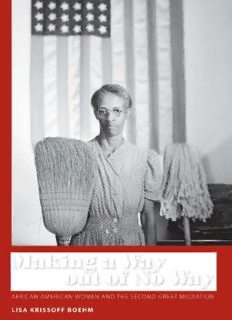
Making a Way out of No Way: African American Women and the Second Great Migration (Margaret Walker Alexander Series in African American Studies) PDF
Preview Making a Way out of No Way: African American Women and the Second Great Migration (Margaret Walker Alexander Series in African American Studies)
Making a Way out of No Way Making a Way out of No Way AFRICAN AMERICAN WOMEN AND THE SECOND GREAT MIGRATION LISA KRISSOFF BOEHM UNIVERSITY PRESS OF MISSISSIPPI / JACKSON www.upress.state.ms.us Margaret Walker Alexander Series in African American Studies The University Press of Mississippi is a member of the Association of American University Presses. Copyright © 2009 by University Press of Mississippi All rights reserved Manufactured in the United States of America Frontispiece (page ii): Cole, Willie, Domestic I.D. IV. 1992. Steam iron scorch and pencil on paper, mounted in recycled wooden window frame, composition (including frame): 35 x 32 x 1 3/8” (88.9 x 81.3 x 3.5 cm). Publisher: unpublished. Printer: the artist and The Artist’s Studio. Edition: unique. Acquired through the generosity of Agnes Gund. Digital Image © The Museum of Modern Art/Licensed by SCALA / Art Resource, NY. First printing 2009 ∞ Library of Congress Cataloging-in-Publication Data Boehm, Lisa Krissoff, 1969– Making a way out of no way : African American women and the second great migration / Lisa Krissoff Boehm. p. cm. — (Margaret Walker Alexander series in African American studies) Includes bibliographical references and index. ISBN 978-1-60473-216-0 (cloth : alk. paper) — ISBN 978-1-60473-217-7 (pbk. : alk. paper) 1. African American women—Social conditions—20th century. 2. African American women—History—20th century. 3. African Americans—Migrations—History—20th cen- tury. 4. Migration, Internal—United States—History— 20th century. 5. Rural-urban migration—United States— History—20th century. 6. African American women— Biography. 7. Oral history—United States. I. Title. E185.86.B6325 2009 305.48'896073—dc22 2008033344 British Library Cataloging-in-Publication Data available For Esther Woods (1913–2005) and Madelon Hack Krissoff, my teachers This page intentionally left blank Contents ix A NOTE ON STYLE xi BIOGRAPHICAL SKETCHES 3 INTRODUCTION 19 CHAPTER ONE Memories of the Southern Childhood 45 CHAPTER TWO Guiding Influences and the Younger Years 79 CHAPTER THREE The Move North 109 CHAPTER FOUR Encountering the City 139 CHAPTER FIVE The Work of a Domestic 175 CHAPTER SIX Family Aspects viii contents 199 CHAPTER SEVEN Experiences with Other Types of Employment 221 CHAPTER EIGHT Reflections on the Migration and a Life of Work 241 ACKNOWLEDGMENTS 245 NOTES 271 BIBLIOGRAPHY 283 INDEX A Note on Style I wish that all of the women who shared their life stories for this book had had the opportunity to meet. They could have talked together about the Second Great Migration, their attitudes towards work and parenting, and the regional differences between North and South. What a wonderful discussion that would have been! I have in effect lived in this imagined gathering during the years I worked on the manuscript. This book is written in a way that allows the women to come together, at least on the page. When a topic is discussed—for instance, the influence of elders, or treatment by employers—various voices join the con- versation, adding personal insights. The reader is a witness to this conversation, just as I am. As with a real-life gathering, the reader does not have to know the complete story of the individual speaking to understand her observation. For readers who would like an occasional reminder of a narrator’s life story, I have written biographical sketches, located at the front of the book for easy reference. These sketches provide short descriptions of the lives of the forty women inter- viewed explicitly for this project. The other voices, drawn from approximately forty additional oral histories located in archival collections, appear intermit- tently and thus are not included in the biographical sketches section. I serve as the narrator of the text, bringing the pieces together and add- ing the historical background necessary for a fuller understanding of the inter- views. Throughout the book, the reader will find extended “edited transcripts,” or large edited segments in one narrator’s voice. These sections are helpful in re-creating the interview experience and in letting a narrator tell her own story in an expanded way. Edited transcripts are used to introduce chapters or book sections. In most cases, the edited transcript on a given subject appears before the historical analysis. This organization was employed with two objectives in mind: 1) the format allows the oral history narrators to speak first, and 2) the ix
Description: